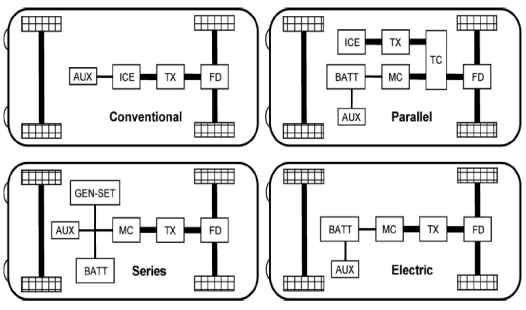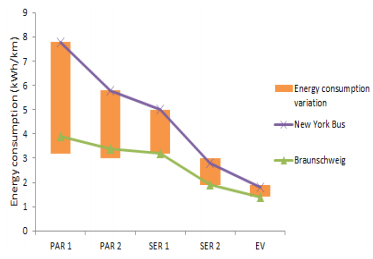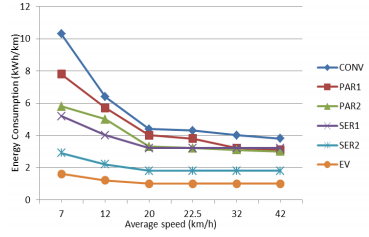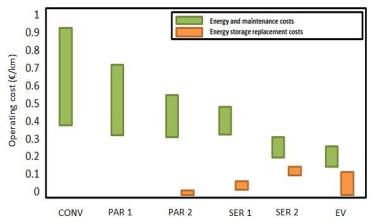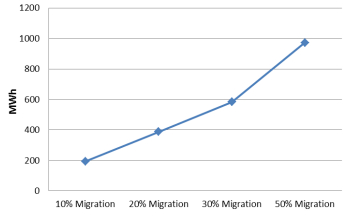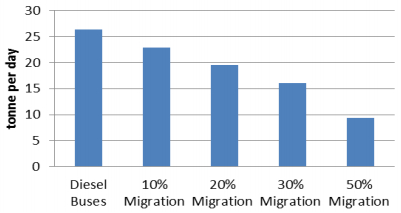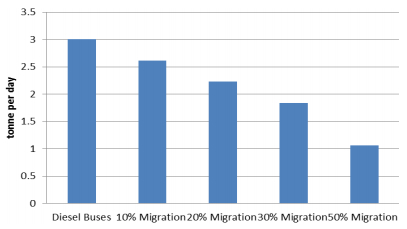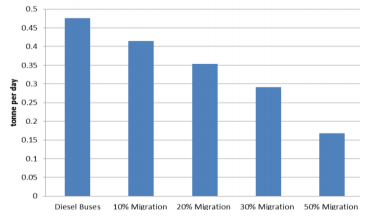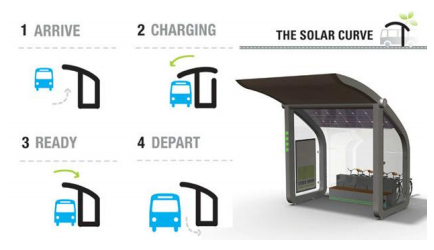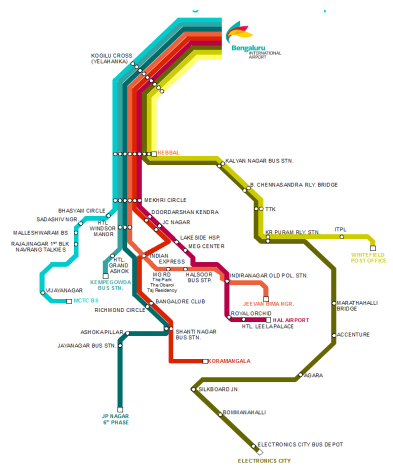Rapid but unplanned urban development coupled with economic growth has resulted in congestion and pollution concerns in Indian cities. This forced India consider taking concrete steps towards design policies that would help stir the nation towards a more sustainable future. India, along with other bigger Asian economies like China, needs to address the growing global concerns over climate change and design their framework and policies to help cut down the greenhouse gas emissions. Transportation is a major source of pollution. A shift towards a pro-public transport policy would solve the traffic congestion problems and address the emission concerns. India has a significantly higher modal share of public transportation in its major cities. Public bus transport system acts as a lifeline to the India’s poor and middle class citizens. The following study focuses on the need for a replacement of conventional fossil fuel dependent buses with Electric buses in the existing public transport bus fleet in the city of Bengaluru. A design has been developed to utilize wireless charging technologies to realize electric bus migration in Bengaluru.
1.
Introduction
The following two-dimensional nonlinear multi-term time-fractional subdiffusion equations with initial and boundary conditions are considered in this paper:
where Ω=(0,L1)×(0,L2) with the boundary ∂Ω, f∈C1(R), and g is a continuous function in Ω. The operator Dαt in (1.1) is defined by
where Dαlt denotes the Caputo derivative with respect to t, i.e.,
In order to describe the physical process better, some scholars use multi-term time fractional differential equations for modeling, such as the behavior of viscoelastic fluids[1,2], the dispersion of pollutants[3], and magnetic resonance imaging[4]. The finite difference method[5,6,7,8], the finite volume method [9,10], the fractional predictor-corrector method[11], the finite element method[12], the collocation method [13,14], and the spectral method[15] have been developed for solving the multi-term time fractional equations. The work [16] proposed a fast linearized finite difference method for the nonlinear multi-term time-fractional wave equation using SOE approximation. Recently, a lot of work about the time fractional nonlinear subdiffusion equation has been published. For example, the paper [17] considered a Newton linearized Galerkin finite element method to solve the problem with non-smooth solutions in the time direction and provided an optimal error estimate by using the discrete fractional Gronwall-type inequality on the graded meshes. The paper [18] provided an efficient systematic framework for solving nonlinear fractional partial differential equations on unbounded domains and obtained an error estimate. Jiang et al. [19] proposed an efficient ADI scheme for the nonlinear subdiffusion equation with a weakly singular solution and obtained the pointwise-in-time error estimate. Li et al. [20] proposed a new tool, the refined discrete fractional-type Gr¨onwall inequality, which is used to derive a sharp pointwise-in-time error estimate of the L1 scheme for the problem. However, as far as the authors know, at present there is no work dedicated to the pointwise-in-time error estimate of the L1 scheme for the nonlinear multi-term time-fractional subdiffusion equation with weakly singular solutions. The present work is designed to fill this gap. Following [21,22], in the remainder of our paper, we make the following assumption:
Assumption 1.1. For all (x,y,t)∈ˉΩ×(0,T], we assume the solution satisfies
where C is a positive constant. C in this paper represents a constant independent of time and space step, and C in different positions represents different values.
This paper consists of the following sections. In Section 2, we construct a fully discrete scheme for the problem (1.1)–(1.3). In Section 3, some lemmas are introduced that will be used in the subsequent analysis. In Section 4, convergence and stability of the fully discrete scheme proposed in Section 2 are given, and we obtain the sharp pointwise-in-time error estimate. In Section 5, the theoretical analysis is verified by four numerical examples.
2.
Fully discrete scheme
Let M1, M2, and N be three positive integers. Divide space and time uniformly into M1×M2 and N parts, respectively. Let {tn|tn=nτ, 0≤n≤N} be a uniform partition of [0,T] with the time step τ=T/N. Let h1=L1/M1 and h2=L2/M2 be the spatial steps. So spatial grid points consist of xi=ih1 and yj=jh2, where i=0,1,⋯,M1 and j=0,1,⋯,M2. The spatial grid is represented by Ω′={(xi,yj)|i=0,1,⋯,M1,j=0,1,⋯,M2}. Let Ωh=Ω′∩Ω, and ∂Ωh=Ω′∩∂Ω. Defining uni,j=u(xi,yj,tn), the previous equations (1.1)–(1.3) at the grid point (xi,yj,tn) can be transformed into
where the notations in (2.1) will be given afterwards.
Applying an L1 formula for the multi-term time Caputo derivatives, i.e., set
where dαlk=τ−αl[k1−αl−(k−1)1−αl]Γ(2−αl). For simplicity, defining dk=J∑l=1bldαlk, it yields that
A standard second-order approximation is used to discretize Δuni,j:
To approximate the nonlinear term f(uni,j), we utilize the backward formula, expressed as
In (2.1), (rl)ni,j and Rni,j are truncation errors, i.e.,
Leaving out the truncation errors in (2.1) and replacing uni,j by Uni,j, the fully discrete scheme is obtained:
3.
Preliminary lemmas
Lemma 3.1. For (xi,yj)∈Ωh, 1≤n≤N, it holds that
Proof. Due to the continuity of f′ and the boundedness of u, f′(ζ) is bounded, where ζ is between uni,j and un−1i,j. We obtain
Then we estimate the truncation error in two cases ([19], page 6). Note the condition (1.5).
Case A: n≥2
where we have used tn−1≃tn for n≥2 in the penultimate inequality.
Case B: n=1
The proof is completed. □
Lemma 3.2. For (xi,yj)∈Ωh, 1≤n≤N, we have |Rni,j|≤C(h21+h22).
Proof. According to the Taylor expansion, we can see that
where xi−1<ξ1<xi+1, and yj−1<ξ2<yj+1. □
Lemma 3.3. [23, Lemma 6] |J∑l=1bl(rl)ni,j|≤Cn−min{2−α1,α1+1}, for (xi,yj)∈Ωh, 1≤n≤N.
Define the positive stability multipliers θ0=μ, θn=μn∑k=1(dk−dk+1)θn−k, where μ=d−11.
Lemma 3.4. ([24], Lemma 5.1) θn is a monotonically decreasing sequence with respect to n. For n=0,1,⋯,N,
Notation. θn here has the following relationship with σαn in Literature [24]: θn=σαn.
Lemma 3.5. ([24], Lemma 5.2, Corollary 5.1) For n=1,2,⋯,N,
where β≥0 and
If there exists α_, which satisfies 0<α_⩽α1<1, we have
where constant ˆC depends on α_ and T.
Lemma 3.6. ([25], Lemma 5.1) If {yn} is a non-negative sequence, and it satisfies yn≤a1t−η1n+a2t−η2n+bτn−1∑j=1tα−1n−jyj, 1≤n≤N, we get yn≤C(a1t−η1n+a2t−η2n), 1≤n≤N, where 0≤η1,η2<1, a1,a2,b>0, 0<α<1 and N is a positive integer.
Suppose gj is an arbitrary mesh function; we define an integral operator Bαt, which satisfies Bαt(g0)=0, Bαt(gn)=n∑j=1θn−jgj, for n=1,2,⋯,N.
Lemma 3.7. ([23], Lemma 2) For any mesh function {Uj}Nj=0, the following formula holds.
4.
Convergence and stability analysis
Theorem 4.1. If Uni,j is the solution of (2.5)–(2.7) at point (xi,yj,tn), and suppose |Uni0,j0|=‖Un‖∞, it holds that
Proof. From (2.5), it is easy to see that Uni,j satisfies
Based on (2.7) and the fact that dαlk−1>dαlk, we have
Then, we obtain
which, according to the definition of Dατ, is equivalent to the following expression:
By applying the integral operator to both sides of the above formula, we obtain
Due to Lemma 3.7 and the above definition of Bαt, (4.1) holds for n≥1. Obviously, (4.1) also holds for n=0. □
Theorem 4.2. Suppose that u is the solution of (1.1)–(1.3) and satisfies Assumption 1.1, and that U is the solution of (2.5)–(2.7). There exist positive constants τ0 and h0. When τ<τ0 and h1,h2<h0, it holds for m>0 that
Proof. For m=0, (4.3) holds obviously. Assuming that (4.3) holds for m=0,1,2⋯n−1(n≥1), then for sufficiently small τ, h1, h2, and 1≤k≤n, we obtain
Let us discuss whether the inequality (4.3) holds when m=n. Let emi,j=umi,j−Umi,j for 0≤m≤n. Subtracting (2.5)–(2.7) from (2.1)–(2.3), we obtain
where (Rf)mi,j=f(um−1i,j)−f(Um−1i,j). Considering the continuity of f′, the boundedness of um−1i,j and Um−1i,j, we have
Let |emi0,j0|=‖em‖∞. Using Lemmas 3.1–3.3 and inequality (4.4), similar to (4.2), it can be obtained that for 1≤m≤n,
Applying the definition of Bαt again, and Lemmas 3.4 and 3.5, we can further obtain
where σ1=min{2−α1,α1+1}. From Lemma 3.6, we have
In summary, the inequality (4.3) holds for m=n, which finishes the mathematical induction. The proof is complete. □
Remark 4.1. The global maximum error of the numerical solution is
When tn is away from 0, the local maximum error is
Theorem 4.3. The fully discrete scheme (2.5)–(2.7) is stable with respect to the initial value. If ˆUni,j satisfies the following equations,
and ‖g−ˆg‖∞ is sufficiently small, then
where ˆeni,j=Uni,j−ˆUni,j.
Proof. Subtracting (4.7)–(4.9) from (2.5)–(2.7) and according to Theorem 4.1, we have
where ˆeni0,j0=‖ˆen‖∞. (4.10) holds for n=0 obviously. Suppose that (4.10) holds when n=0,1,2,⋯,m−1(m≥1), we have ‖ˆUr‖∞≤‖ˆer‖∞+‖Ur‖∞≤C‖ˆe0‖∞+‖Ur‖∞≤1+‖Ur‖∞ on the condition that ‖ˆe0‖∞ is small, for r≤m−1. According to (4.3), Uri,j is bounded. Then, combining the continuity of f′ and the boundedness of ˆUri,j, it holds that
Due to Lemma 3.6, we have
Therefore, the mathematical induction ends, and the proof is complete. □
5.
Numerical experiments
Example 5.1. We first consider the following two-term time-fractional nonlinear subdiffusion equation with b1=b2=1.
where h(x,y,t) and g(x,y) are up to the exact solution. We set the exact solution to tα1sin(πx)sin(πy), which satisfies Assumption 1.1. We consider the spatial domain Ω=(0,1)×(0,1) and set T=1.
Above all, we compute the convergence order in spatial direction. We set N=1000 so that the influence of errors in temporal direction can be ignored compared with errors in spatial direction. The maximum errors at tn=1 and rates, when α1=0.4 and α2=0.3, are presented in Table 5.1. Numerical results show that the spatial accuracy is O(h21+h22). For studying temporal convergence rates, we define global errors EG and local errors EL by
Global errors and rates in Table 5.2 show that the global temporal convergence order is α1. When tn is far away from 0, results are shown in Table 5.3, and we get the local temporal accuracy O(τ). All in all, numerical results are consistent with the theoretical analysis in Remark 1.
Example 5.2. Secondly, we consider a two-dimensional three-term time-fractional nonlinear subdiffusion equation with b1=b2=b3=1.
where Ω=(0,1)×(0,1) and T=1. We calculate h(x,y,t) and g(x,y) based on the exact solution
Numerical results are shown in Tables 5.4 and 5.5, which verify the theoretical analysis as well.
Example 5.3. Thirdly, we investigate the scenario in which the nonlinear term is represented by f(u)=sin(u), which satisfies Lipschitz condition. The corresponding equation is formulated as follows:
where Ω=(0,1)×(0,1) and T=1. Similarly, we derive h(x,y,t) and g(x,y) based on the exact solution
The corresponding numerical results are presented in Tables 5.6 and 5.7. The global convergence order is α1, and the local convergence order is 1 in the temporal direction.
Example 5.4. Finally, we consider a two-dimensional two-term time-fractional nonlinear subdiffusion equation with b1=b2=1, whose exact solution is unknown.
where Ω=(0,1)×(0,1) and T=1.
The two-mesh method[26] is applied to compute errors and convergence rates. We take M1=M2=60. EL is redefined by
in which Wn is the numerical solution of Example 5.4 with τ=T/2N. The local errors are shown in Table 5.8. The local temporal convergence rate O(τ) is consistent with Remark 1.
Use of AI tools declaration
The authors declare they have not used Artificial Intelligence (AI) tools in the creation of this article.
Acknowledgments
The research is supported in part by the Natural Science Foundation of Shandong Province under Grant ZR2023MA077, Fundamental Research Funds for the Central Universities (No. 202264006), and the National Natural Science Foundation of China under Grant 11801026.
Conflict of interest
The authors declare there are no conflicts of interest.









 DownLoad:
DownLoad:


